Abstract
Aerobic and facultatively anaerobic bacteria isolated from false-positive, presumptive, total coliform, most-probable-number tests of Chesapeake Bay oyster, water, and sediment samples were characterized and then classified by numerical taxonomy. A total of 538 bacterial strains clustered into 17 phena, the predominant groups of which were Enterobacteriaceae (including Escherichia coli), Aeromonas spp., and Bacillus spp. Bacillus spp. were recovered most frequently from sediment samples. Gas-producing strains which were not members of the Enterobacteriaceae were not isolated during this study. However, disproportionately large numbers of atypical and anaerogenic lactose-fermenting strains were encountered. We concluded that no single, specific bacterial group can be identified as being responsible for the false-positive reaction in the presumptive coliform test. Instead, the false-positive reaction is a result of complex interactions among various genera, representing predominantly bacteria other than coliforms.
Full text
PDF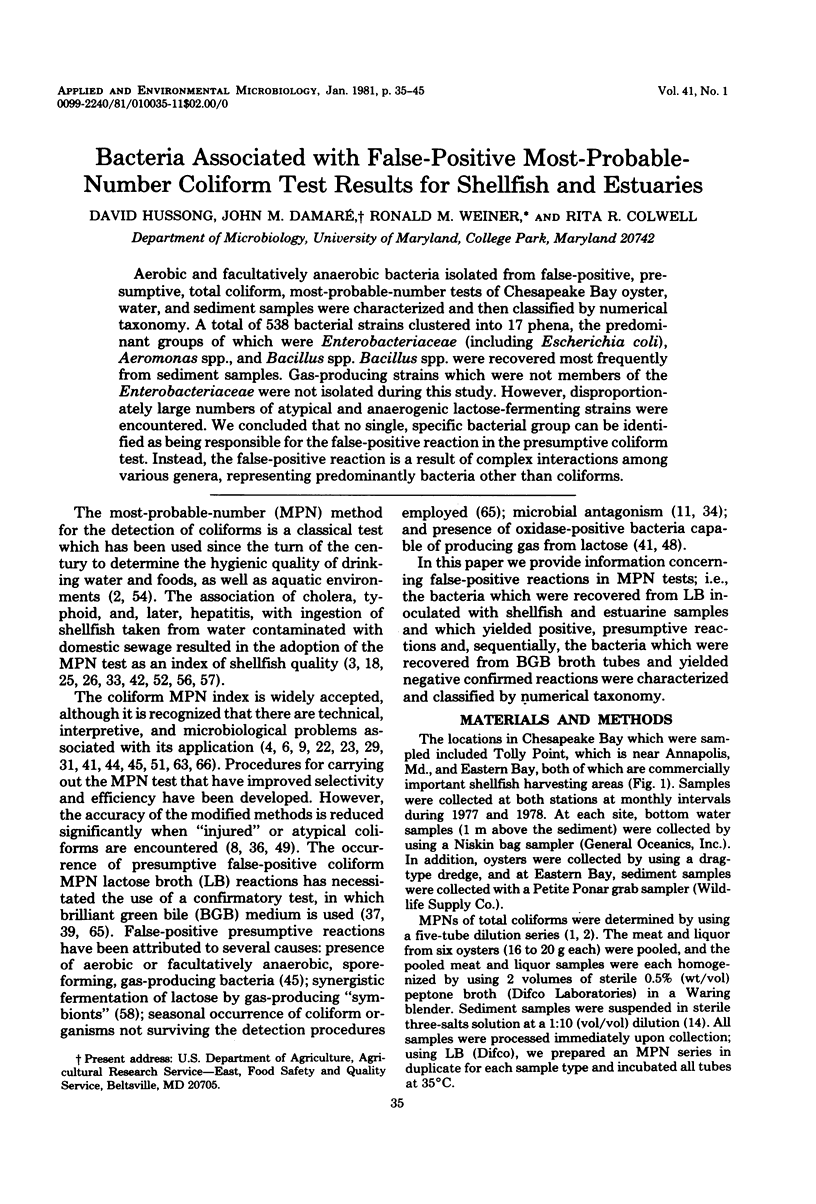
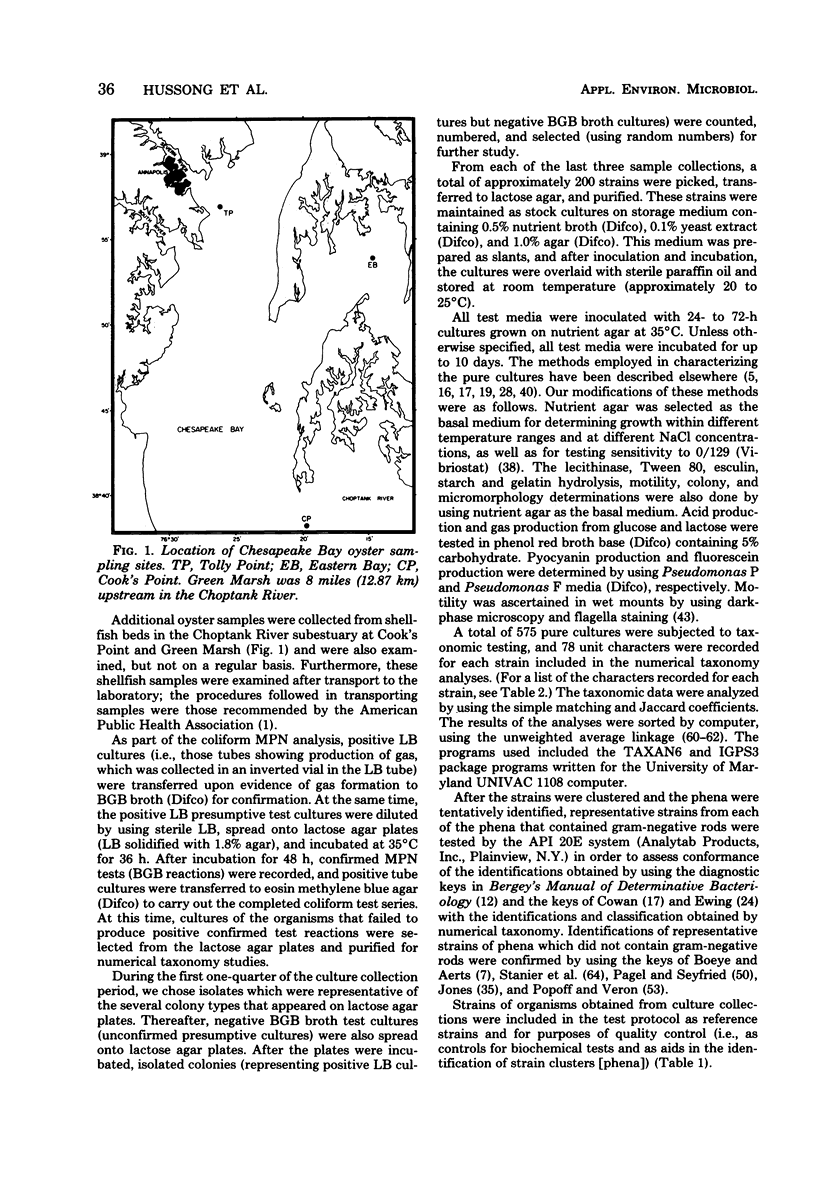
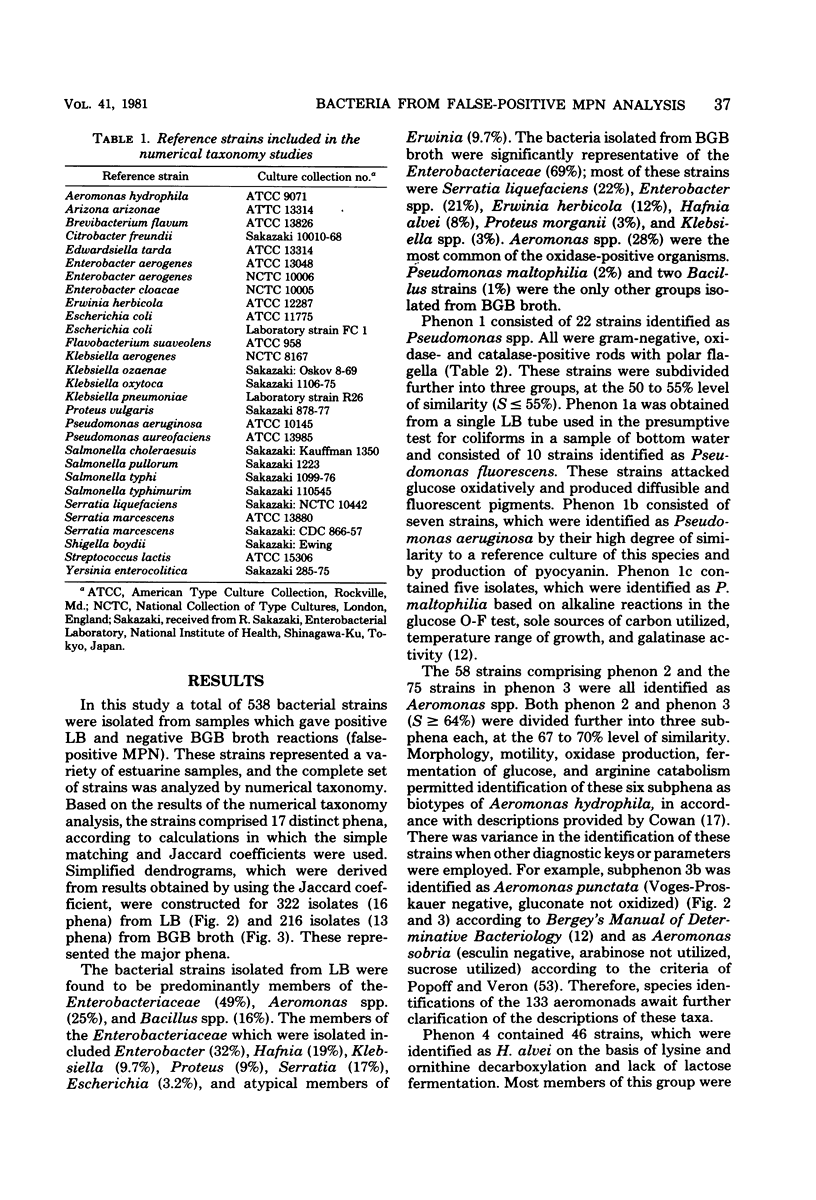
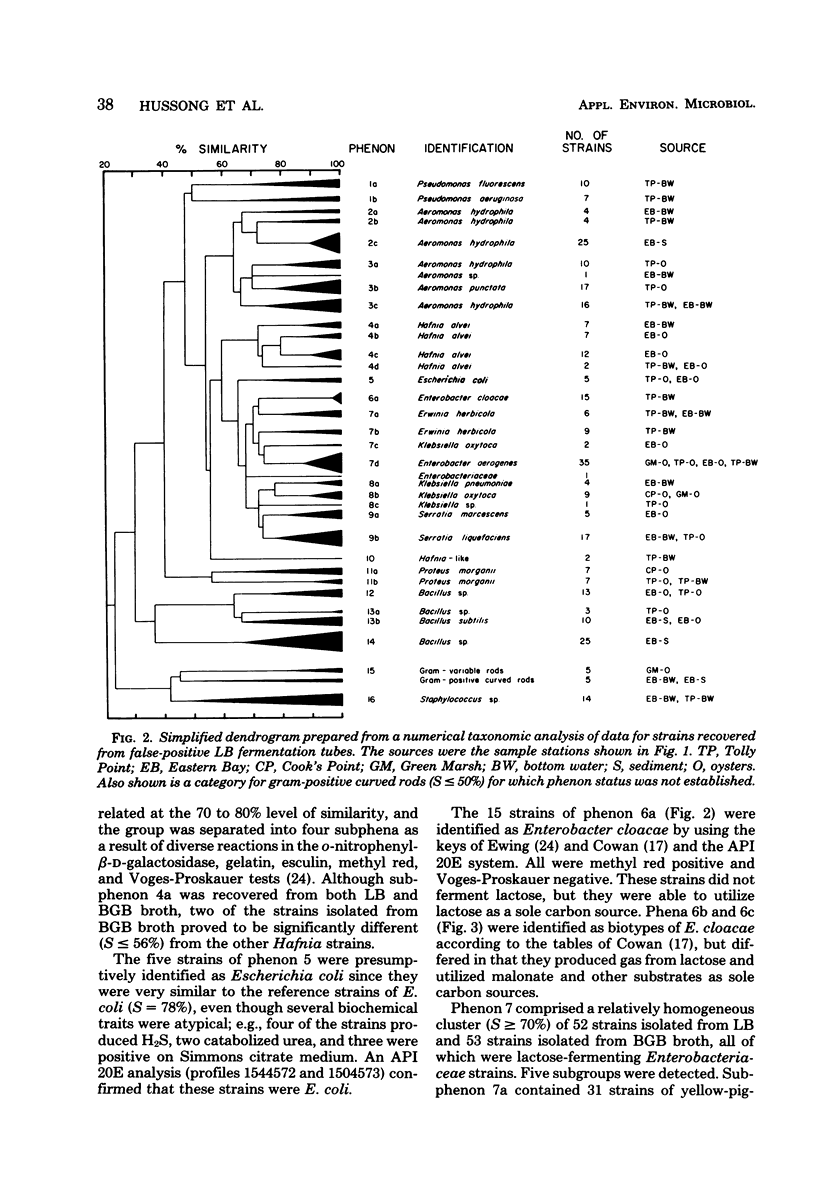

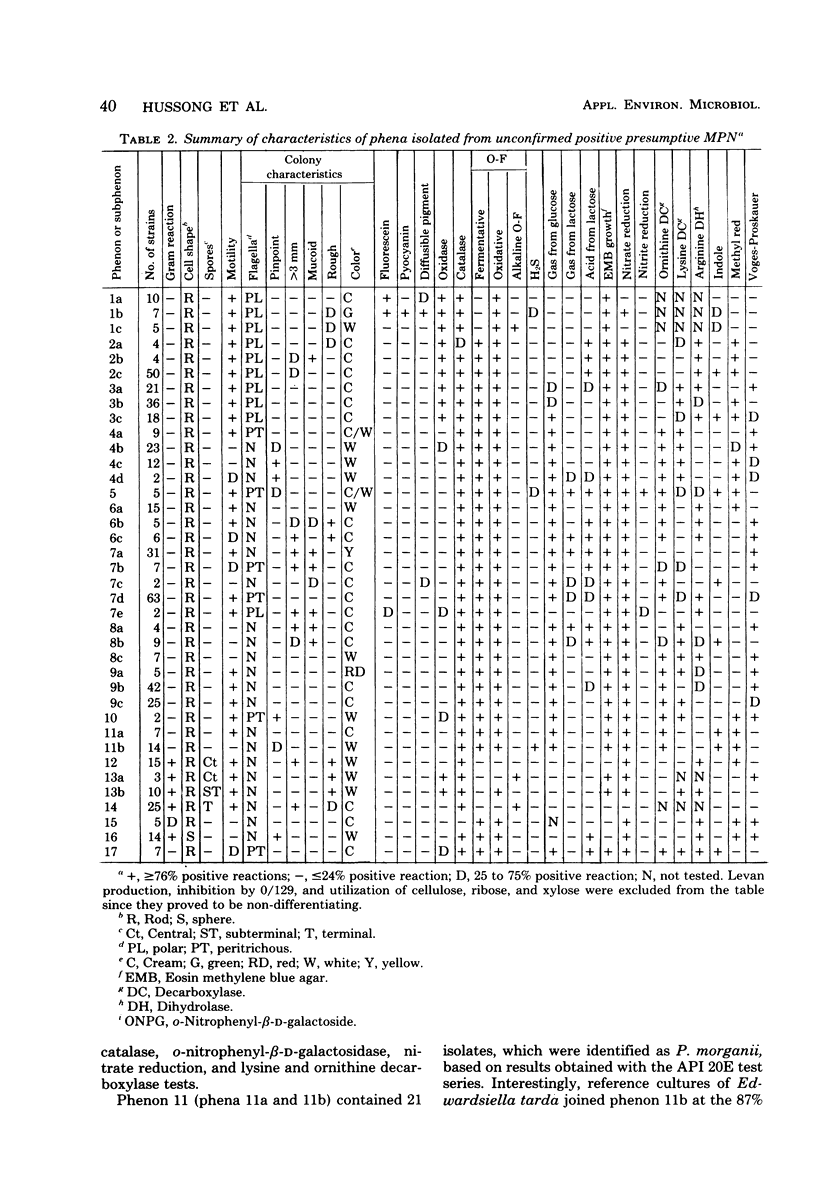
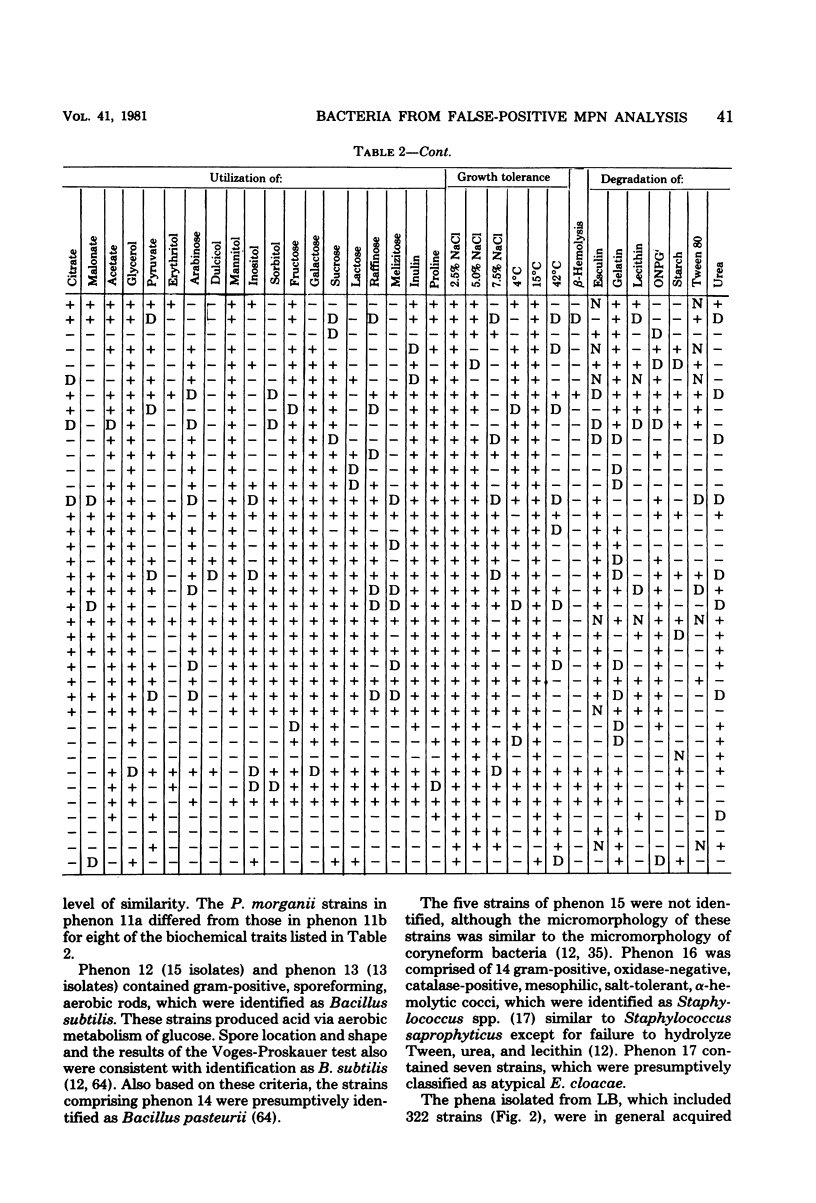
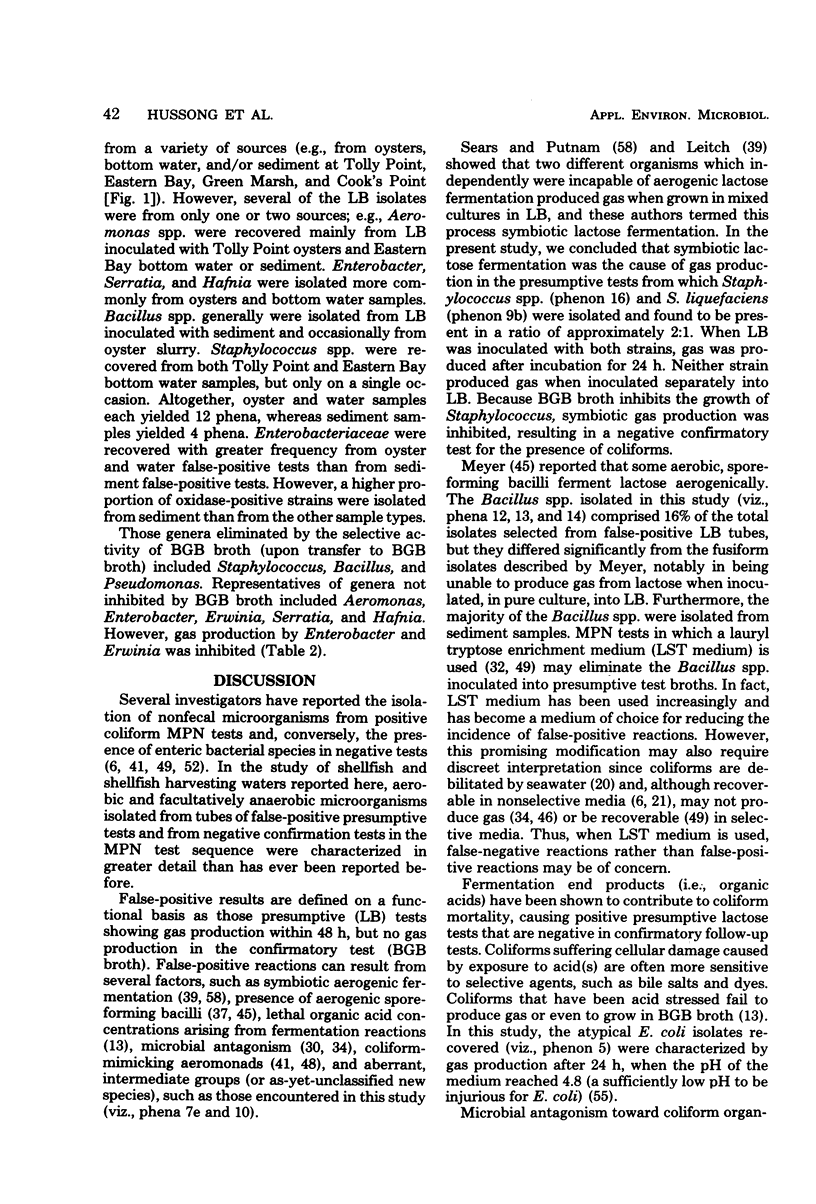
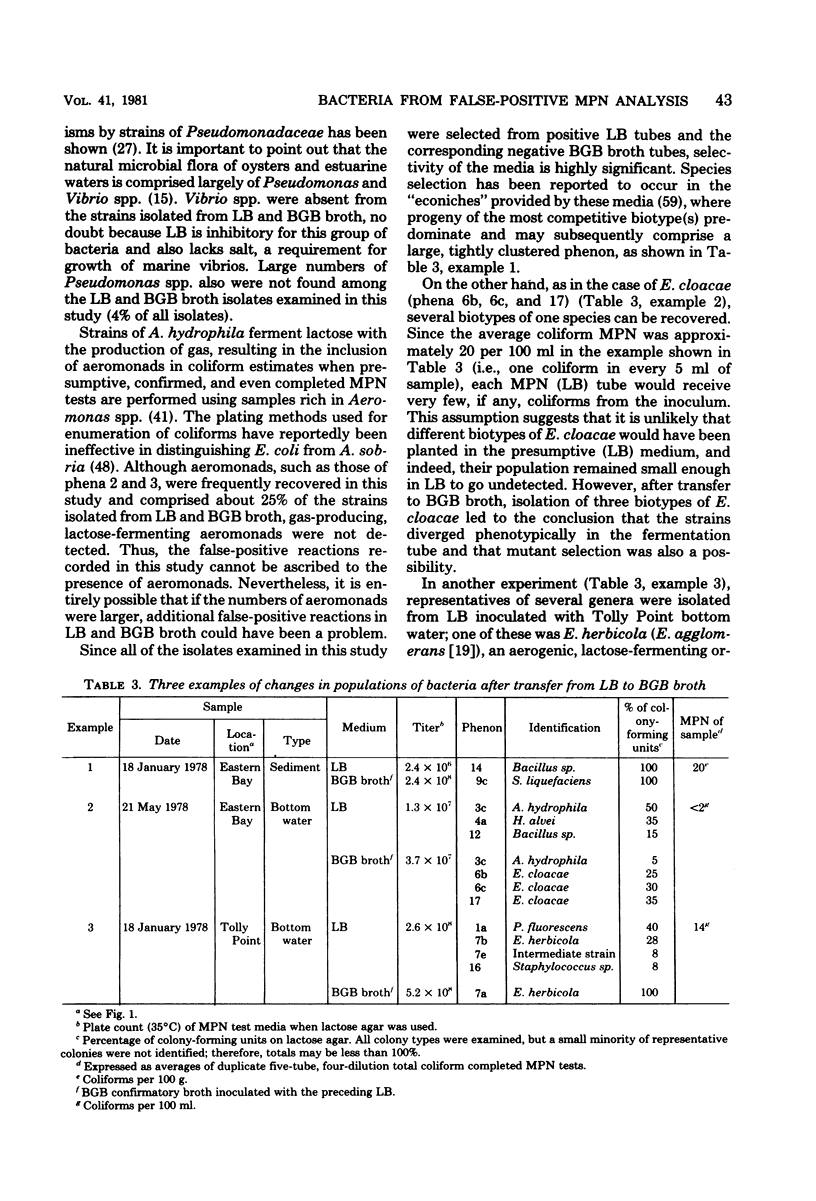
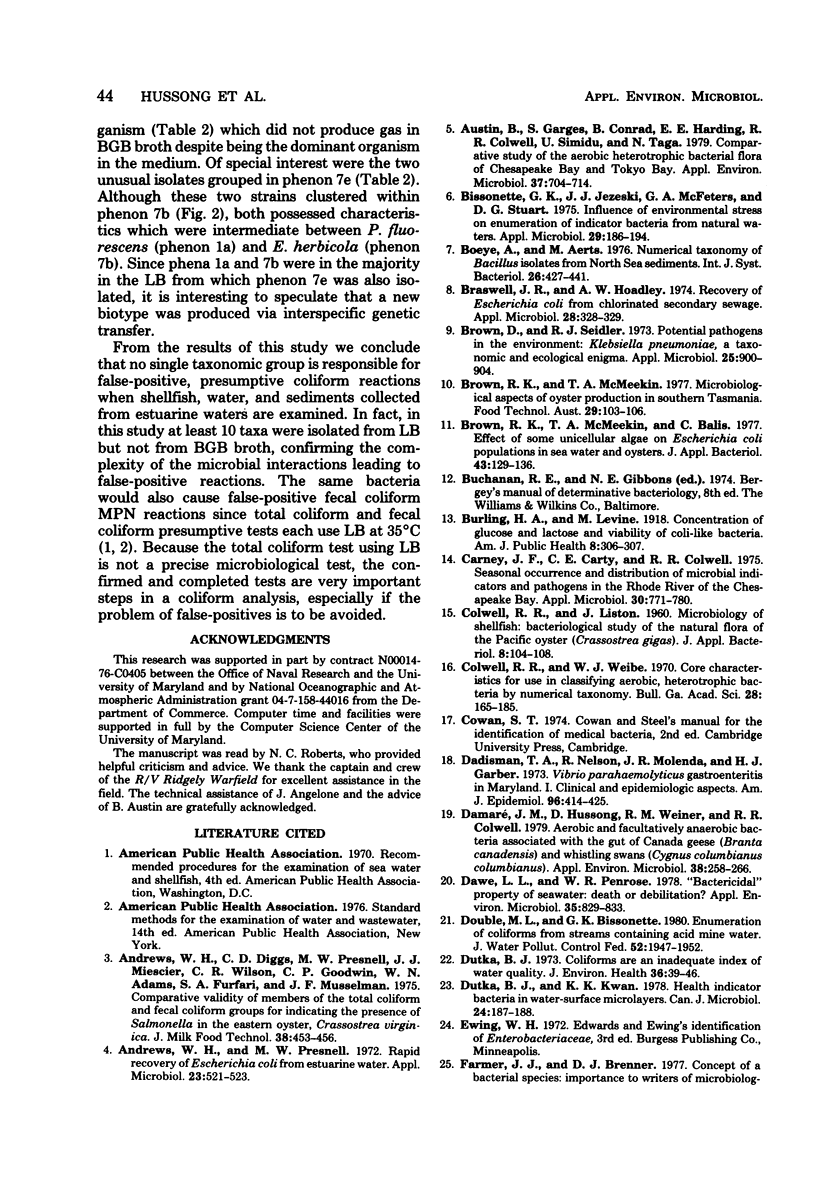
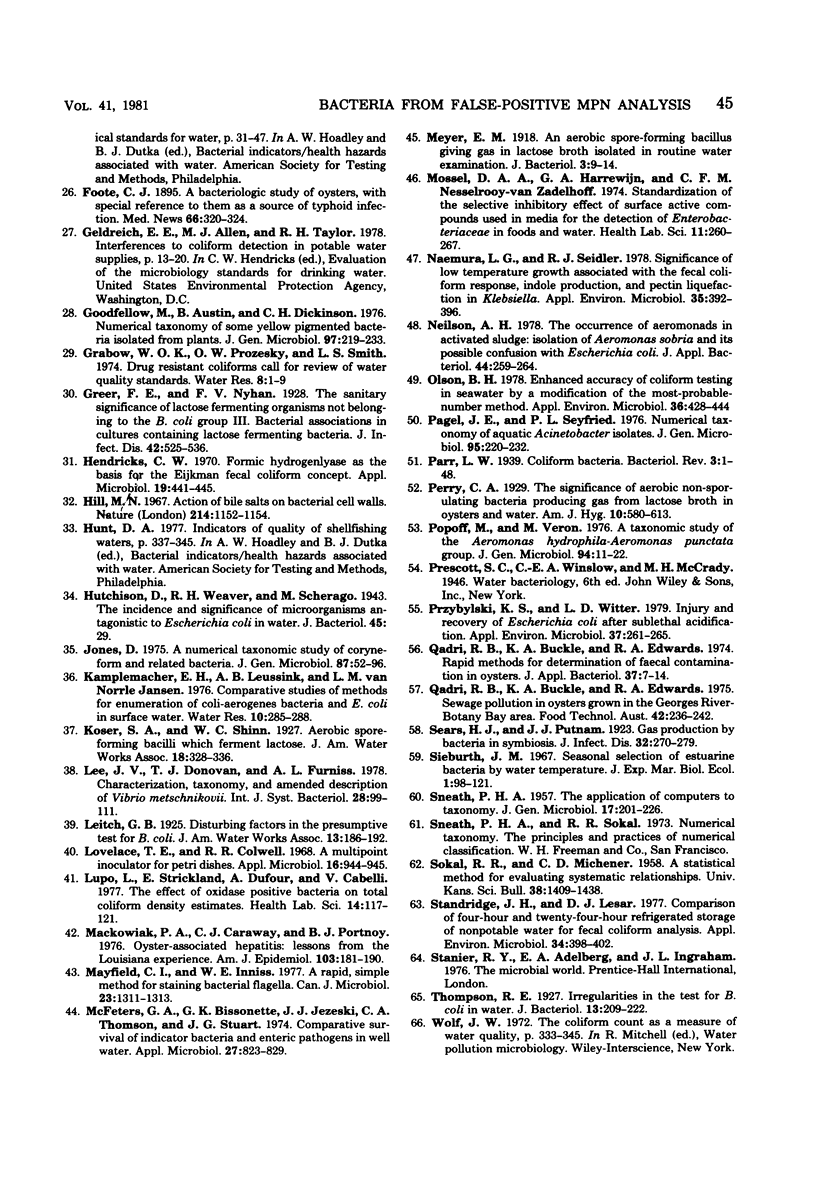
Selected References
These references are in PubMed. This may not be the complete list of references from this article.
- Andrews W. H., Presnell M. W. Rapid recovery of Escherichia coli from estuarine water. Appl Microbiol. 1972 Mar;23(3):521–523. doi: 10.1128/am.23.3.521-523.1972. [DOI] [PMC free article] [PubMed] [Google Scholar]
- Austin B., Garges S., Conrad B., Harding E. E., Colwell R. R., Simidu U., Taga N. Comparative study of the aerobic, heterotrophic bacterial flora of Chesapeake Bay and Tokyo Bay. Appl Environ Microbiol. 1979 Apr;37(4):704–714. doi: 10.1128/aem.37.4.704-714.1979. [DOI] [PMC free article] [PubMed] [Google Scholar]
- Bissonnette G. K., Jezeski J. J., McFeters G. A., Stuart D. G. Influence of environmental stress on enumeration of indicator bacteria from natural waters. Appl Microbiol. 1975 Feb;29(2):186–194. doi: 10.1128/am.29.2.186-194.1975. [DOI] [PMC free article] [PubMed] [Google Scholar]
- Braswell J. R., Hoadley A. W. Recovery of Escherichia coli from chlorinated secondary sewage. Appl Microbiol. 1974 Aug;28(2):328–329. doi: 10.1128/am.28.2.328-329.1974. [DOI] [PMC free article] [PubMed] [Google Scholar]
- Brown C., Seidler R. J. Potential pathogens in the environment: Klebsiella pneumoniae, a taxonomic and ecological enigma. Appl Microbiol. 1973 Jun;25(6):900–904. doi: 10.1128/am.25.6.900-904.1973. [DOI] [PMC free article] [PubMed] [Google Scholar]
- Brown R. K., McMeekin T. A., Balis C. Effect of some unicellular algae on Escherichia coli populations in sea water and oysters. J Appl Bacteriol. 1977 Aug;43(1):129–136. doi: 10.1111/j.1365-2672.1977.tb00731.x. [DOI] [PubMed] [Google Scholar]
- Burling H. A., Levine M. CONCENTRATION OF GLUCOSE AND LACTOSE AND VIABILITY OF COLI-LIKE BATERIA. Am J Public Health (N Y) 1918 Apr;8(4):306–307. doi: 10.2105/ajph.8.4.306. [DOI] [PMC free article] [PubMed] [Google Scholar]
- COLWELL R. R., LISTON J. Microbiology of shellfish. Bacteriological study of the natural flora of Pacific oysters (Crassostrea gigas). Appl Microbiol. 1960 Mar;8:104–109. doi: 10.1128/am.8.2.104-109.1960. [DOI] [PMC free article] [PubMed] [Google Scholar]
- Carney J. F., Carty C. E., Colwell R. R. Seasonal occurrence and distribution of microbial indicators and pathogens in the Rhode River of Chesapeake Bay. Appl Microbiol. 1975 Nov;30(5):771–780. doi: 10.1128/am.30.5.771-780.1975. [DOI] [PMC free article] [PubMed] [Google Scholar]
- Dadisman T. A., Jr, Nelson R., Molenda J. R., Garber H. J. Vibrio parahaemolyticus gastroenteritis in Maryland. I. Clinical and epidemiologic aspects. Am J Epidemiol. 1972 Dec;96(6):414–426. doi: 10.1093/oxfordjournals.aje.a121474. [DOI] [PubMed] [Google Scholar]
- Damaré J. M., Hussong D., Weiner R. M., Colwell R. R. Aerobic and facultatively anaerobic bacteria associated with the gut of Canada geese (Branta canadensis) and whistling swans (Cygnus columbianus columbianus). Appl Environ Microbiol. 1979 Aug;38(2):258–266. doi: 10.1128/aem.38.2.258-266.1979. [DOI] [PMC free article] [PubMed] [Google Scholar]
- Dawe L. L., Penrose W. R. "Bactericidal" property of seawater: death or debilitation? Appl Environ Microbiol. 1978 May;35(5):829–833. doi: 10.1128/aem.35.5.829-833.1978. [DOI] [PMC free article] [PubMed] [Google Scholar]
- Dutka B. J., Kwan K. K. Health--indicator bacteria in water--surface microlayers. Can J Microbiol. 1978 Feb;24(2):187–188. doi: 10.1139/m78-032. [DOI] [PubMed] [Google Scholar]
- Goodfellow M., Austin B., Dickinson C. H. Numerical taxonomy of some yellow-pigmented bacteria isolated from plants. J Gen Microbiol. 1976 Dec;97(2):219–233. doi: 10.1099/00221287-97-2-219. [DOI] [PubMed] [Google Scholar]
- Hendricks C. W. Formic hydrogenlyase induction as a basis for the Eijkman fecal coliform concept. Appl Microbiol. 1970 Mar;19(3):441–445. doi: 10.1128/am.19.3.441-445.1970. [DOI] [PMC free article] [PubMed] [Google Scholar]
- Hill M. J. Action of bile salts on bacterial cell walls. Nature. 1967 Jun 10;214(5093):1152–1154. doi: 10.1038/2141152a0. [DOI] [PubMed] [Google Scholar]
- Jones D. A numerical taxonomic study of coryneform and related bacteria. J Gen Microbiol. 1975 Mar;87(1):52–96. doi: 10.1099/00221287-87-1-52. [DOI] [PubMed] [Google Scholar]
- Lovelace T. E., Colwell R. R. A multipoint inoculator for petri dishes. Appl Microbiol. 1968 Jun;16(6):944–945. doi: 10.1128/am.16.6.944-945.1968. [DOI] [PMC free article] [PubMed] [Google Scholar]
- Lupo L., Strickland E., Dufour A., Cabelli V. The effect of oxidase positive bacteria on total coliform density estimates. Health Lab Sci. 1977 Apr;14(2):117–121. [PubMed] [Google Scholar]
- Mackowiak P. A., Caraway C. T., Portnoy B. L. Oyster-associated hepatitis: lessons from the Louisiana experience. Am J Epidemiol. 1976 Feb;103(2):181–191. doi: 10.1093/oxfordjournals.aje.a112216. [DOI] [PubMed] [Google Scholar]
- Mayfield C. I., Inniss W. E. A rapid, simple method for staining bacterial flagella. Can J Microbiol. 1977 Sep;23(9):1311–1313. doi: 10.1139/m77-198. [DOI] [PubMed] [Google Scholar]
- McFeters G. A., Bissonnette G. K., Jezeski J. J., Thomson C. A., Stuart D. G. Comparative survival of indicator bacteria and enteric pathogens in well water. Appl Microbiol. 1974 May;27(5):823–829. doi: 10.1128/am.27.5.823-829.1974. [DOI] [PMC free article] [PubMed] [Google Scholar]
- Meyer E. M. An Aerobic Spore-forming Bacillus Giving Gas in Lactose Broth Isolated in Routine Water Examination. J Bacteriol. 1918 Jan;3(1):9–14. doi: 10.1128/jb.3.1.9-14.1918. [DOI] [PMC free article] [PubMed] [Google Scholar]
- Mossel D. A., Harrewijn G. A., Nesselrooy-van Zadelhoff C. F. Standardization of the selective inhibitory effect of surface active compounds used in media for the detection of Enterobacteriaceae in foods and water. Health Lab Sci. 1974 Oct;11(4):260–267. [PubMed] [Google Scholar]
- Naemura L. G., Seidler R. J. Significance of low-temperature growth associated with the fecal coliform response, indole production, and pectin liquefaction in Klebsiella. Appl Environ Microbiol. 1978 Feb;35(2):392–396. doi: 10.1128/aem.35.2.392-396.1978. [DOI] [PMC free article] [PubMed] [Google Scholar]
- Olson B. H. Enchanced accuracy of coliform testing in seawater by a modification of the most-probable-number method. Appl Environ Microbiol. 1978 Sep;36(3):438–444. doi: 10.1128/aem.36.3.438-444.1978. [DOI] [PMC free article] [PubMed] [Google Scholar]
- Pagel J. E., Seyfried P. L. Numerical taxonomy of aquatic Acinetobacter isolates. J Gen Microbiol. 1976 Aug;96(2):220–232. doi: 10.1099/00221287-95-2-220. [DOI] [PubMed] [Google Scholar]
- Parr L. W. COLIFORM BACTERIA. Bacteriol Rev. 1939 Jun;3(1):1–48. doi: 10.1128/br.3.1.1-48.1939. [DOI] [PMC free article] [PubMed] [Google Scholar]
- Popoff M., Véron M. A taxonomic study of the Aeromonas hydrophila-Aeromonas punctata group. J Gen Microbiol. 1976 May;94(1):11–22. doi: 10.1099/00221287-94-1-11. [DOI] [PubMed] [Google Scholar]
- Przybylski K. S., Witter L. D. Injury and recovery of Escherichia coli after sublethal acidification. Appl Environ Microbiol. 1979 Feb;37(2):261–265. doi: 10.1128/aem.37.2.261-265.1979. [DOI] [PMC free article] [PubMed] [Google Scholar]
- Qadri R. B., Buckle K. A., Edwards R. A. Rapid methods for the determination of faecal contamination in oysters. J Appl Bacteriol. 1974 Mar;37(1):7–14. doi: 10.1111/j.1365-2672.1974.tb00410.x. [DOI] [PubMed] [Google Scholar]
- SNEATH P. H. The application of computers to taxonomy. J Gen Microbiol. 1957 Aug;17(1):201–226. doi: 10.1099/00221287-17-1-201. [DOI] [PubMed] [Google Scholar]
- Standridge J. H., Lesar D. J. Comparison of four-hour and twenty-four-hour refrigerated storage of nonpotable water for fecal coliform analysis. Appl Environ Microbiol. 1977 Oct;34(4):398–402. doi: 10.1128/aem.34.4.398-402.1977. [DOI] [PMC free article] [PubMed] [Google Scholar]
- Thompson R. E. IRREGULARITIES IN THE TEST FOR B. COLI IN WATER. J Bacteriol. 1927 Mar;13(3):209–221. doi: 10.1128/jb.13.3.209-221.1927. [DOI] [PMC free article] [PubMed] [Google Scholar]


